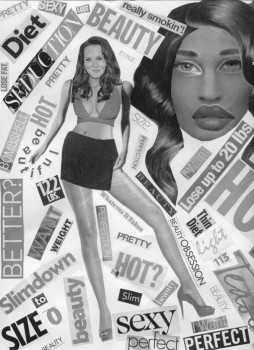This article was published in the Spring 2011 Southerner News Magazine.
At a young age I was introduced to a world where Barbies were not just a children’s toy, but a living, breathing model of perfection.
I spent years in the same room, in front of the same mirror, with the same group of girls. In that exact ballet studio, I can still remember the framed photos on every wall of the faultless dancers. We rehearsed for hours just to achieve the ideal pointed foot and flawless alignment present in the photographs.
It would be a lie to say I never compared myself to the ballerinas on the wall, or even to my fellow classmates on those days we stood in front of that glistening glass mirror. We began to notice a major pattern in the older dancers at the school; the higher the level they were in, the thinner they appeared to be. In a study by the National Heart, Lung and Blood Institute, 40% of the nine and ten year-olds surveyed said that they had tried to lose weight.
For many of the young girls in my class, ballet was all they’d ever known; their mothers had been dancers, their older sisters were dancers, so they too were a part of the cycle. As we danced from level to level, the harsh realities of the art began to slowly weave through the minds of my peers.
We would often flip through magazines filled with the familiar faces of celebrities and models, admired for their perfect clothing, hair and body. A page was flipped to the image of a 120-pound actress, she was called fat and ugly by the voices of my classmates. It took only one comment to open my eyes to the world I was living in.
The average woman is said to weigh around 140 pounds, whereas the average model maintains a weight 15 to 20 percent lower than what is considered healthy for their age and height. These are the standards that young women today feel they need to acquire to be beautiful.
The fact of the matter is that these so-called standards that have been established are unattainable. We are being raised in a society where self worth is achieved through others’ thoughts and opinions.
When looking through magazines or watching television, it’s nice to think that what you are viewing is real. You can see anything from golden tans, stick-thin waists, huge breasts, and glistening faces. Such images are in the media for one reason and that is to make a sale. According to a study on the media’s effect on body image, 53% of American girls were dissatisfied with their bodies. They taunt young girls with such images because they know we will look at something we perceive to be beautiful and think, how could I be more like her?
Only last November a French model by the name of Isabelle Caro passed away from her ongoing battle with anorexia. Caro was twenty-eight years old, and her lowest weight being a shocking 60 pounds. Shortly before her death Caro modeled for an Italian ad campaign raising awareness for anorexia, where she exposed her ghostly body made up of skin and protruding bones.
A few years earlier, Madrid’s fashion week began to ban models from walking in the show if their body mass index was too low. 30% of the models who had participated in previous years were not allowed to strut the thin strip of runway. The overall goal was to promote a healthier image for the young viewers, who often look up to the models that walk before them.
Although the fashion industry is quite different from that of the dance world, they both share similar values. To be successful, you need to be thin.
I enjoyed ballet because it offered me a way to discover my inner grace, but never did I wish to pursue it past my youth. No longer did I want to question myself in front of that mirror, so I quit ballet, with some hope of finding beauty for what it should be.







